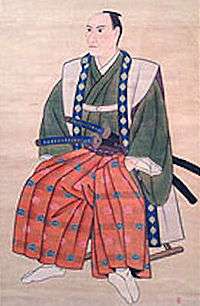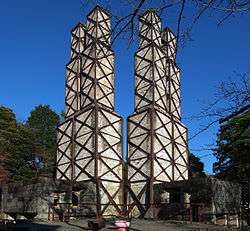Egawa Hidetatsu
| Ebara Soroku 江原素六 | |
|---|---|
 Egawa Hidetatsu autoportrait | |
| Born |
June 23, 1801 Nirayama, Shizuoka, Japan |
| Died |
March 4, 1855 (aged 53) Japan |
| Nationality | Japanese |
| Occupation | educator, politician |
Egawa Hidetatsu Tarōzaemon (江川英龍太郎左衛門, June 23, 1801 - March 1, 1855) was a Japanese Bakufu intendant of the 19th century.[1] He was Daikan, in charge of the domains of the Tokugawa shogunate in Izu, Sagami and Kai Provinces during the Bakumatsu period.[2] He took a leading role in the reinforcement of Japanese coastal defenses against Western encroachments in the 19th century.
Coastal defenses
Due to his holdings on the coast, Egawa Hidetatsu was involved in issues of coastal defences, critical to Japan at that time. He was in relations with the group of Watanabe Kazan,[2] and Takano Chōei.[3]

Egawa Hidetatsu was put in charge of establishing the defense of Edo Bay against Western intrusions in 1839,[5] following the incident of the Morrison under Charles W. King in 1837. In 1841, Egawa permitted the gunnery demonstrations of Takashima Shūhan to the Tokugawa Shogunate.[6]
As early as 1842, Egawa attempted to build a furnace to cast weapons in the village of Nirayama in the Izu Peninsula. After sending a student to study the furnace which had been built in the Saga Domain, a new furnace was built which succeeded in casting cannons in 1858, after the death of Egawa.[7]
Egawa taught Western gunnery and techniques to numerous men who would later have a role in the Meiji Restoration.[8] He also advocated the conscription of farmers into the army.[8]


Egawa also designed and built the battery emplacements at the entrance of Edo harbour at Odaiba in 1853/54, following the 1853 visit of Commodore Perry and his promise to return the following year.[8][9] The fortifications were built to prevent the intrusion near Tokyo of the foreign ships.[10] Commodore Perry would effectively stop his fleet at Uraga, southward at the entrance of Edo Bay, fully prepared for hostilities if his negotiations with the Japanese failed.[11] His ships were equipped with modern Paixhans shell guns, capable of bringing destruction everywhere a shell landed.[12][13]
Westernization debate
Egawa was involved in an important debate at that time, whether to adopt Western guns and methods or not. He advocated that the English had shown great superiority over the Chinese in the 1840 Opium War, and that it was necessary to use their own techniques to repel them. Others, such as Torii Yōzō argued that only traditional Japanese methods should be employed and reinforced.[14] Egawa argued that just as Confucianism and Buddhism had been introduced from abroad, it made sense to introduce useful Western techniques.[14] Sakuma Shōzan was a student of a school founded by Egawa Hidetatsu.[15]
A theoretical synthesis of "Western knowledge" and "Eastern morality" would later be accomplished by Sakuma Shōzan and Yokoi Shōnan, in view of "controlling the barbarians with their own methods".[16]
At one point Egawa hired the services of Nakahama Manjirō, a Japanese castaway who had spent 10 years in the West before returning to Japan, in order to obtain better knowledge of the West.[17]
See also
- Shōshikai
- Late Tokugawa Shogunate
Notes
- ↑ Jansen, Hall 1989, p. 815.
- 1 2 Jansen, Hall 1989, p. 108.
- ↑ Cullen 2003, p. 159.
- ↑ A Dutch book entitled The Casting Processes at the National Iron Cannon Foundry in Luik ( Het Gietwezen ins Rijks Iizer-Geschutgieterij, to Luik) written in 1826 by Huguenin Ulrich (1755-1833) was used as a reference to build the furnace.
- ↑ Cullen 2003, pp. 158-159.
- ↑ Jansen 2002, p. 287.
- ↑ Smith 1955, p. 6.
- 1 2 3 Fukuzawa Kiyooka 2007, p. 340.
- ↑ Watanabe 2001, p. 143.
- ↑ Knafelc 2004, p. 95.
- ↑ Takekoshi 2004, pp. 285-86.
- ↑ Millis 1981, p. 88.
- ↑ Walworth 2008, p. 21.
- 1 2 Jansen 1995, p. 124.
- ↑ Jansen 1995, p. 127.
- ↑ Jansen 1995, pp. 126-130.
- ↑ Kawada, Nagakuni, Kitadai 2004, p. 128.
References
- Cullen, Louis M. A history of Japan 1582-1941: internal and external worlds (2003 ed.). Cambridge University Press. ISBN 0-521-52918-2. - Total pages: 357
- Yukichi Fukuzawa, Eiichi Kiyooka Translated by Eiichi Kiyooka. The autobiography of Yukichi Fukuzawa (2007 ed.). Columbia University Press. ISBN 0-231-13987-X. - Total pages: 477
- Jansen, Marius B. The Emergence of Meiji Japan (when ed.). Cambridge University Press. ISBN 0-521-48405-7. - Total pages: 351
- The making of modern Japan (2002 ed.). Harvard University Press. ISBN 0-674-00991-6. - Total pages: 871
- Jansen, Marius B.; Whitney Hall, John. The Cambridge History of Japan: The nineteenth century (1989 ed.). Cambridge University Press. ISBN 0-521-22356-3. - Total pages: 886
- Ikaku Kawada; Junya Nagakuni; Junji Kitadai. Drifting toward the Southeast: the story of five Japanese castaways : a complete translation of Hyoson kiryaku (2004 ed.). Spinner Publications. ISBN 0-932027-56-3. - Total pages: 144
- Kara Knafelc. Tokyo (2004 ed.). Lonely Planet. ISBN 1-74059-450-9. - Total pages: 274
- Walter Millis. Arms and men: a study in American military history (1981 ed.). Rutgers University Press. ISBN 0-8135-0931-9. - Total pages: 382
- Thomas Carlyle Smith. Political change and industrial development in Japan: government enterprise, 1868-1880 (1955 ed.). Stanford University Press. ISBN 0-8047-0469-4. - Total pages: 126
- Yosaburō Takekoshi. The economic aspects of the history of the civilization of Japan, Volume 3 (2004 ed.). Taylor & Francis. ISBN 0-415-32381-9. - Total pages: 456
- Arthur Walworth. Black Ships Off Japan - The Story of Commodore Perry's Expedition (2008 ed.). Read Books. ISBN 1-4437-2850-0. - Total pages: 320
- Hiroshi Watanabe. The architecture of Tôkyô: an architectural history in 571 individual (2001 ed.). Axel Menges. ISBN 3-930698-93-5. - Total pages: 263